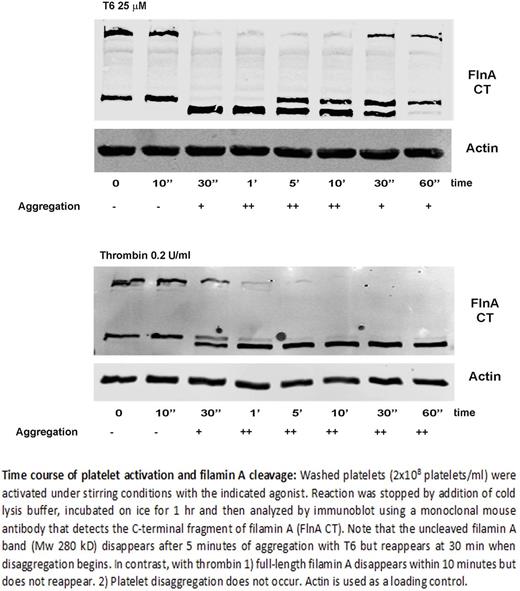Platelet integrin αIIbβ3, glycoprotein-Ib (GPIb), and integrin α2β1 bind extracellular ligands fibrinogen, von Willebrand Factor (vWF), and collagen, respectively. These liganded receptors, in turn, connect the extracellular matrix to the cytoskeleton via a variety of cytoskeletal linker proteins. Once linked to the cytoskeleton, these receptors can transduce mechanical shear force encountered in the circulation to the cytoskeleton. Both GPIb and αIIbβ3 have been shown to function as mechano-transduction receptors, but still unknown is how the mechanical force modifies the cytoskeletal proteins that transduce the signal at the molecular level. We previously demonstrated that in platelets filamin A (FlnA): 1) undergoes a conformational change downstream of ligand binding to αIIbβ3, glycoprotein Ib (GPIb), or α2β1 in the presence of shear that renders it cleavable by calpain, and 2. FlnA cleavage occurs after lysis activates platelet calpain by release of calcium from internal stores and generates a 180 kD N-terminal fragment and a 100 kD C-terminal fragment; under some conditions the latter is further cleaved into 90 and 10 kD fragments. We now report that: 1. Platelets activated with thrombin-receptor activating peptide (T6), ADP, convulxin (Cvx), thrombin, or ristocetin (R) under static conditions without stirring bind Alexa 647-labeled fibrinogen and the αIIbβ3 activation-dependent mAb PAC-1, but do not undergo FlnA cleavage after lysis; 2. Platelets activated with the same agonists under conditions of shear with stirring undergo time-dependent changes in FlnA cleavage after lysis as follows: a) by 10 minutes after aggregation is initiated, there is robust platelet aggregation and full-length FlnA (280 kD) is no longer detectable, indicating that nearly all of the platelet FlnA undergoes the conformational change in this time frame; b) by 15-60 minutes after aggregation is initiated, platelets begin to partially disaggregate and some full-length, uncleaved FlnA is again identified, indicating that the conformational change is reversible and correlates with the extent of platelet aggregation/disaggregation. 3. In contrast to the reversible nature of platelet aggregation and FlnA cleavage when platelets are activated with T6, ADP, Cvx, collagen, or ristocetin, when platelets are activated by thrombin (0.2 U/ml) and stirred, there is no observable disaggregation even after 60 min of activation and FlnA remains cleavable throughout the time course. Our data indicate that: 1. fibrinogen binding to αIIbβ3 exerts tension on FlnA, exposing its calpain binding sites, but only under conditions of shear and aggregation, indicating that the platelet can sense the physical properties of its surrounding environment and convert that information into conformational changes in FlnA, 2. the conformational change in FlnA is reversible when platelets disaggregate, even when they remain in a high shear environment, and 3. Fibrin(ogen) binding to αIIbβ3 induced by thrombin in the presence of shear leads to irreversible platelet aggregation and an irreversible change in the FlnA conformation. We conclude that FlnA conformation is a sensitive indicator of the combination of adhesive protein binding, ambient shear, and platelet-platelet interaction.
No relevant conflicts of interest to declare.
Author notes
Asterisk with author names denotes non-ASH members.


This feature is available to Subscribers Only
Sign In or Create an Account Close Modal